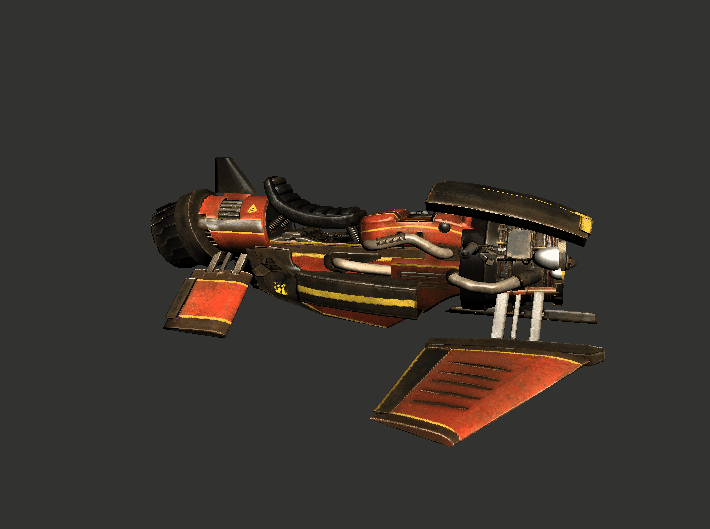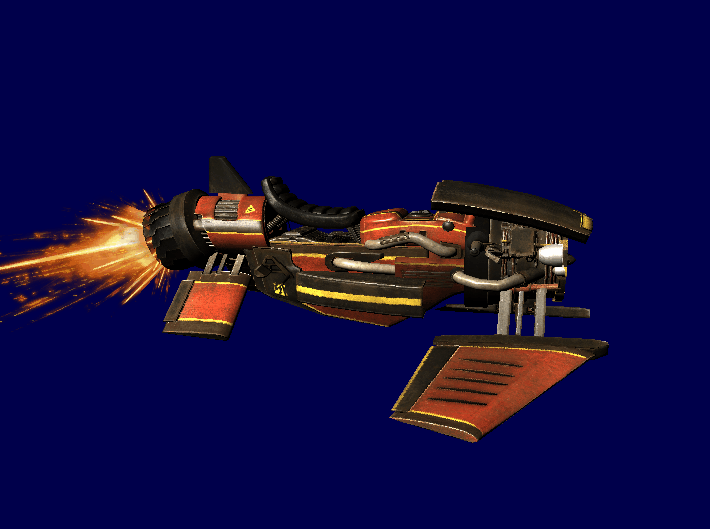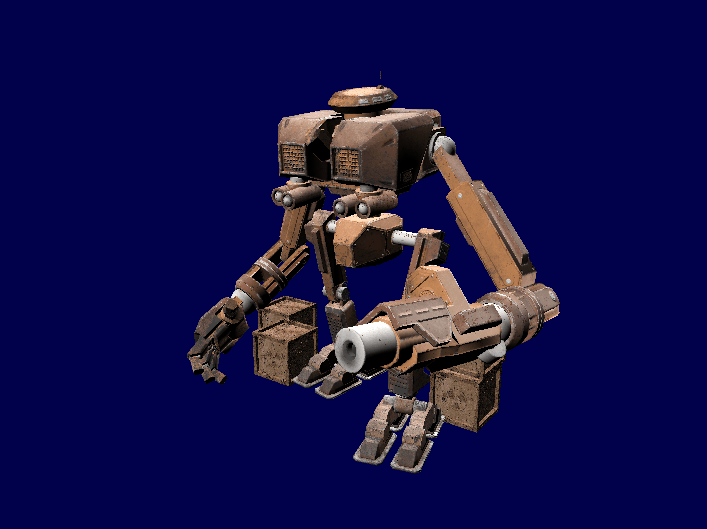Description
After having made a custom Ray Tracer from scratch, this Rasterizer was its follow-up on my graphics programming journey. The main focus of this project was getting familiar with the rendering pipeline and understanding the fundamental steps of it by re-creating it from scratch. Different topics compared to the Ray Tracer were introduced here.
As a follow-up, the same Rasterizer was made in the DirectX11 framework and has the functionality to toggle between the software and hardware Rasterizer. In my free time, I’ve profiled and refactored the project and made it possible to support multiple lights as well as a PBR implementation of the Cook-Torrance BRDF (as seen in my Ray Tracer project).
Topics Covered
- Linear Algebra (Vector- and Matrix math)
- Coordinate Systems
- Ray Intersections
- Orthographic/Perspective Camera
- Orthonormal Base (ONB)
- Depth Buffer
- Depth Interpolation
- Textures & Vertex Attributes
- Texture Sampling & Filtering
- BRDF's (Lambert, Phong, Cook-Torrance)
- Physically Based Rendering (PBR)
- DirectX Graphics Pipeline
- Transparency (Partial Coverage)
- OBJ Parser
Though with all the progress, this Rasterizer can definitely be expanded upon in terms of optimization or extra features such as Multithreading, Indirect Lighting, Reflections, Shadows, and Anti-Aliasing to name a few.
Most Interesting Code Snippets
bool Triangle::Hit(const Elite::FPoint2& pixel, HitRecord& hitRecord) const
{
//Before anything else, if we have a NoCulling setting we get visual artifacts
//That's why we're going to determine what side we're looking at from the get-go, and simply cull away the opposite of that
ECullMode cullmode = m_CullMode;
if (cullmode == ECullMode::NoCulling)
{
//Calculate normal for this triangle (reference: raytracer normal pre-calculation)
FVector3 v0_v1 = FVector3(m_InputVertices[1].Position - m_InputVertices[0].Position);
FVector3 v0_v2 = FVector3(m_InputVertices[2].Position - m_InputVertices[0].Position);
FVector3 normal = Elite::GetNormalized(Elite::Cross(v0_v1, v0_v2));
float dot = Elite::Dot(normal, hitRecord.ViewDirection);
if (dot > 0)
{
//Means we're looking in the same direction as the normal -> backface normal -> so cull front
cullmode = ECullMode::FrontCulling;
}
else
{
//Means we're looking in the same direction as the normal -> frontface normal -> so cull back
cullmode = ECullMode::BackCulling;
}
}
//Total area needed to decide the weight of a vertex later
FVector2 a{ m_TransformedVertices[1].Position - m_TransformedVertices[0].Position };
FVector2 b{ m_TransformedVertices[2].Position - m_TransformedVertices[0].Position };
float totalArea = Cross(b, a);
std::array<float, 3> weights;
//Check first edge
FVector2 edgeA{ m_TransformedVertices[1].Position - m_TransformedVertices[0].Position };
FVector2 toPixel{ pixel - FPoint2(m_TransformedVertices[0].Position) };
//Inside-outside test
//Cullmode integration (tried doing it the same way using dot products like in raytracer -> results in artifacts)
//-> Figured it could have to do with the order of how vertices are defined (counterclockwise vs clockwise)
//-> On discord people explained how in the inside outside test:
//-> We can check the signs of the cross products along with the cullmode to determine if it should be visible or not
float signedArea = Cross(toPixel, edgeA);
//Cullmode check
if (cullmode == ECullMode::BackCulling && (signedArea < 0)) return false;
else if (cullmode == ECullMode::FrontCulling && (signedArea > 0)) return false;
//Set weight of v2
weights[2] = signedArea / totalArea;
//Continue with next edge
FVector2 edgeB{ m_TransformedVertices[2].Position - m_TransformedVertices[1].Position };
toPixel = pixel - FPoint2(m_TransformedVertices[1].Position);
//Cullmode check
signedArea = Cross(toPixel, edgeB);
if (cullmode == ECullMode::BackCulling && (signedArea < 0)) return false;
else if (cullmode == ECullMode::FrontCulling && (signedArea > 0)) return false;
//Set weight of v0
weights[0] = signedArea / totalArea;
//Continue with last edge
FVector2 edgeC{ m_TransformedVertices[0].Position - m_TransformedVertices[2].Position };
toPixel = pixel - FPoint2(m_TransformedVertices[2].Position);
//Cullmode check
signedArea = Cross(toPixel, edgeC);
if (cullmode == ECullMode::BackCulling && (signedArea < 0)) return false;
else if (cullmode == ECullMode::FrontCulling && (signedArea > 0)) return false;
//Set weight of v1
weights[1] = signedArea / totalArea;
//Interpolated values
hitRecord.InterpolatedZ = GetInterpolatedDepthInSS(weights);
hitRecord.InterpolatedW = GetInterpolatedDepthInVS(weights);
hitRecord.InterpolatedColor = GetInterpolatedColor(weights, hitRecord.InterpolatedW);
hitRecord.InterpolatedUV = GetInterpolatedUV(weights, hitRecord.InterpolatedW);
hitRecord.InterpolatedVertexNormal = GetInterpolatedVertexNormal(weights, hitRecord.InterpolatedW);
hitRecord.InterpolatedTangent = GetInterpolatedTangent(weights, hitRecord.InterpolatedW);
hitRecord.ViewDirection = GetInterpolatedViewDirection(weights, hitRecord.InterpolatedW);
hitRecord.MatID = m_MaterialID;
return true;
}void Triangle::TransformVertices(float width, float height, const Elite::FMatrix4& worldMatrix, Camera* pCamera, const KeyBindInfo& keyBindInfo, bool invertToRHS)
{
//Since the vertices are parsed for DirectX (LHS) we have to revert it to work for our SRAS in RHS
if (invertToRHS)
InvertAttributesToRHS(m_InputVertices);
//Gather camera variables
const auto& cameraToWorld = pCamera->GetLookAtMatrix();
const auto& projMatrix = pCamera->GetProjMatrix();
//Model to WorldSpace -> to ViewSpace -> to Projection Space
Elite::FMatrix4 worldViewProjMatrix = projMatrix * Elite::Inverse(cameraToWorld) * ((invertToRHS) ? Elite::Inverse(worldMatrix) : worldMatrix);
for (int i = 0; i < 3; ++i)
{
//Copy over attributes
m_TransformedVertices[i].Color = m_InputVertices[i].Color;
m_TransformedVertices[i].UV = m_InputVertices[i].UV;
//Transform normals and tangents in ONLY WORLD SPACE
m_TransformedVertices[i].VertexNormal = FMatrix3(worldMatrix) * GetNormalized(m_InputVertices[i].VertexNormal);
m_TransformedVertices[i].Tangent = FMatrix3(worldMatrix) * GetNormalized(m_InputVertices[i].Tangent);
//Make world position and store view directions
m_TransformedVertices[i].WorldPosition = worldMatrix * FPoint4(m_InputVertices[i].Position, 1.f);
m_ViewDirection[i] = GetNormalized(m_TransformedVertices[i].WorldPosition - FPoint4(pCamera->GetPosition(), 1.f));
//Model in homogeneous Space -> Clipping Space
m_TransformedVertices[i].Position = worldViewProjMatrix * FPoint4(m_InputVertices[i].Position, 1.f);
}
//Simple frustum culling that culls away the triangle as soon as 1 vertex is out of the view plane
if (keyBindInfo.UseSimpleFrustumCulling)
{
DoSimpleFrustumCulling();
if (!m_IsInsideFrustum)
return;
}
//3D Clipping applied on the triangle (only culls when all vertices are out of view plane)
else
{
//Clear clipped triangles
m_ClippedTriangles.clear();
m_IsTriangleClipped = false;
//For now I'm only testing clipping to the left side of the screen
DoClippingX();
if (!m_IsInsideFrustum)
return;
}
//Only applies in case 3D clipping is applied -> will further transform all the newly made triangles
if (m_IsTriangleClipped)
{
for (Triangle& t : m_ClippedTriangles)
{
//Further transformation of spaces
for (int i = 0; i < 3; ++i)
{
//Clipping space to NDC space
//Perspective divide! -> ViewSpace z value is now stored in the w-component
float viewSpaceZ = t.m_TransformedVertices[i].Position.w;
t.m_TransformedVertices[i].Position.x /= viewSpaceZ;
t.m_TransformedVertices[i].Position.y /= viewSpaceZ;
t.m_TransformedVertices[i].Position.z /= viewSpaceZ;
//Screen Space
t.m_TransformedVertices[i].Position.x = (t.m_TransformedVertices[i].Position.x + 1) / 2.f * width;
t.m_TransformedVertices[i].Position.y = (1 - t.m_TransformedVertices[i].Position.y) / 2.f * height;
}
}
}
//Transform original triangle vertices in case no clipping was necessary
else
{
for (int i = 0; i < 3; ++i)
{
//Clipping space to NDC space
//Perspective divide! -> ViewSpace z value is now stored in the w-component
float viewSpaceZ = m_TransformedVertices[i].Position.w;
m_TransformedVertices[i].Position.x /= viewSpaceZ;
m_TransformedVertices[i].Position.y /= viewSpaceZ;
m_TransformedVertices[i].Position.z /= viewSpaceZ;
//Screen Space
m_TransformedVertices[i].Position.x = (m_TransformedVertices[i].Position.x + 1) / 2.f * width;
m_TransformedVertices[i].Position.y = (1 - m_TransformedVertices[i].Position.y) / 2.f * height;
}
}
}
void Elite::Renderer::RenderSRAS(const std::vector<TriangleMesh*>& pTriangleMeshes, const MaterialManager& materials, const LightManager& lights, Camera* pCamera, const KeyBindInfo& keyBindInfo)
{
SDL_LockSurface(m_pBackBuffer);
//Clear depth and color buffer
for (uint32_t r = 0; r < m_Height; ++r)
{
for (uint32_t c = 0; c < m_Width; ++c)
{
m_DepthBuffer[c + (r * m_Width)] = FLT_MAX;
m_pBackBufferPixels[c + (r * m_Width)] = SDL_MapRGB(m_pBackBuffer->format,
static_cast<uint8_t>(50),
static_cast<uint8_t>(50),
static_cast<uint8_t>(50));
}
}
//For every triangle mesh
const auto& pLights = lights.GetLights();
for (TriangleMesh* pTriangleMesh : pTriangleMeshes)
{
//Check if valid
if (!pTriangleMesh->IsValid())
continue;
//Gather data from triangle mesh
const auto& indexBuffer = pTriangleMesh->GetIndexBuffer();
const auto& vertices = pTriangleMesh->GetVertexBuffer();
Topology topology = pTriangleMesh->GetPrimitiveTopology();
size_t incrementValue = (topology == Topology::TriangleList) ? 3 : 1;
bool swapOnOdd = (topology == Topology::TriangleList) ? false : true;
//Start looping over all indices
for (size_t i = 0; i < indexBuffer.size() - 2; i += incrementValue)
{
//Create triangle
Triangle t = (swapOnOdd && i & 1)
? Triangle //Swap last 2 indices on odd triangle in strip
(
Vertex_Input{ vertices[indexBuffer[i]] },
Vertex_Input{ vertices[indexBuffer[i + 2]] },
Vertex_Input{ vertices[indexBuffer[i + 1]] }
)
: Triangle //Else continue making triangles from a list or even triangle in strip
(
Vertex_Input{ vertices[indexBuffer[i]] },
Vertex_Input{ vertices[indexBuffer[i + 1]] },
Vertex_Input{ vertices[indexBuffer[i + 2]] }
);
//Transform triangle
t.TransformVertices((float)m_Width, (float)m_Height, pTriangleMesh->GetWorldMatrix(), pCamera, keyBindInfo, true);
//If triangle already isn't valid, continue
if (!t.IsInsideFrustum())
continue;
//Set cullmode for upcoming hit check
t.SetCullMode(pTriangleMesh->GetCullMode());
//If triangle is clipped, loop over the pixels surrounding that triangle and render
if (t.IsTriangleClipped())
{
auto& clippedTriangles = t.GetClippedTriangles();
for (const Triangle& clippedTriangle : clippedTriangles)
{
PixelLoop(clippedTriangle, materials, pLights, keyBindInfo);
}
}
//Else loop over the pixels surrounding the current triangle and render
else
{
PixelLoop(t, materials, pLights, keyBindInfo);
}
}
}
SDL_UnlockSurface(m_pBackBuffer);
SDL_BlitSurface(m_pBackBuffer, 0, m_pFrontBuffer, 0);
SDL_UpdateWindowSurface(m_pWindow);
}Elite::RGBColor Elite::Renderer::PixelShading(const HitRecord& hitRecord, const MaterialManager& materialManager, const std::vector<Light*>& pLights, const KeyBindInfo& keyBindInfo)
{
//Coloring in the returned result
RGBColor finalColor{};
if (keyBindInfo.UseDepthBufferAsColor)
{
//Use depth as gradient for color
float depthColor = Elite::Remap(hitRecord.InterpolatedZ, 0.985f, 1.f);
finalColor = { depthColor, depthColor, depthColor };
}
else
{
//If not using material, then use the color defined in the triangle
if (keyBindInfo.UseMaterial)
{
//Get sampled texture color from texture matching the triangle
Material* pMat = materialManager.GetMaterialByID(hitRecord.MatID);
if (!pMat)
return RGBColor(0, 0, 0);
//------ Diffuse ------
Elite::RGBColor diffuse{};
float diffuseReflectance = pMat->GetDiffuseReflectance();
if (pMat->UseDiffuseMap())
{
diffuse = pMat->GetDiffuseTexture()->Sample(hitRecord.InterpolatedUV) * diffuseReflectance;
}
else
{
diffuse = pMat->GetDiffuseColor() * diffuseReflectance;
}
//------ Normal ------
FVector3 newNormal{};
if (pMat->UseNormalMap())
{
//We define our tangent space
FVector3 binormal = Cross(hitRecord.InterpolatedTangent, hitRecord.InterpolatedVertexNormal);
FMatrix3 localTangentSpace = FMatrix3(hitRecord.InterpolatedTangent, binormal, hitRecord.InterpolatedVertexNormal);
//Sample normal map
Elite::RGBColor normalSample = pMat->GetNormalTexture()->Sample(hitRecord.InterpolatedUV);
//An RBG Color goes from [0, 255] range, while we will need this in [-1, 1]
//Sampled value is already returned in range [0, 1]
normalSample = (normalSample * 2.f) - RGBColor(1.f, 1.f, 1.f);
//Transform to tangent space
newNormal = GetNormalized(localTangentSpace * FVector3(normalSample.r, normalSample.g, normalSample.b));
}
else
{
//This value is already normalized
newNormal = hitRecord.InterpolatedVertexNormal;
}
//Data to store information while contributing every light
for (Light* pLight : pLights)
{
//------ Irradiance ------
Elite::RGBColor irradiance = pLight->GetCalculatedIrradianceColor(newNormal, true);
//Decide what BRDF to use:
Material::MaterialWorkflow workflow{ pMat->GetMaterialWorkflow() };
if (workflow == Material::MaterialWorkflow::SpecGloss)
{
//------ Phong BRDF ------
//------ Specular ------
//Color
RGBColor specColor{};
if (pMat->UseSpecularMap())
{
specColor = pMat->GetSpecularTexture()->Sample(hitRecord.InterpolatedUV);
}
else
{
specColor = pMat->GetSpecularColor();
}
//Shininess
float shininess = pMat->GetShininess();
if (pMat->UseGlossinessMap())
{
shininess *= pMat->GetGlossinessTexture()->Sample(hitRecord.InterpolatedUV).r;
}
//Reflectance
float specReflectance = pMat->GetSpecularReflectance();
//Because of lightDir being initialized for a LHS in DX, we have to invert Z to get same effect
FVector3 lightDir = pLight->GetDirection(hitRecord, true);
RGBColor specularReflect = BRDF::Phong(specReflectance, shininess, -lightDir, hitRecord.ViewDirection, newNormal);
Elite::RGBColor phongSpecular = specColor * specularReflect;
//Adding up contribution
finalColor += irradiance * (diffuse / float(E_PI)) + phongSpecular;
}
else if (workflow == Material::MaterialWorkflow::MetalRough)
{
//------ Lambert Cook-Torrance BRDF ------
//Because of lightDir being initialized for a LHS in DX, we have to invert Z to get same effec
FVector3 lightDir = pLight->GetDirection(hitRecord, true);
//------ Roughness ------
float roughness = 0.6f;
if (pMat->UseRoughnessMap())
{
roughness = pMat->GetRoughnessTexture()->Sample(hitRecord.InterpolatedUV).r;
}
//------ Metallic ------
int metallic = 0;
if (pMat->UseMetalnessMap())
{
float metalSample = pMat->GetMetalnessTexture()->Sample(hitRecord.InterpolatedUV).r;
if (metalSample > 0.5f)
metallic = 1;
else if (metalSample < 0.5f)
metallic = 0;
}
//LambertCookTorrance BRDF
RGBColor lamertCookTorranceBRDF = BRDF::LambertCookTorrance(diffuse, metallic, roughness, -lightDir, hitRecord.ViewDirection, newNormal);
//Adding up contribution
finalColor += irradiance * lamertCookTorranceBRDF;
}
}
}
else
{
finalColor = hitRecord.InterpolatedColor;
}
}
//Call max to one on color overflow
if (finalColor.r > 1.f || finalColor.g > 1.f || finalColor.b > 1.f)
finalColor.MaxToOne();
return finalColor;
}CREDITS
Credits to Matthieu Delaere, a lecturer at Howest DAE for writing the base files (math library timer, color structs, SDL window).



